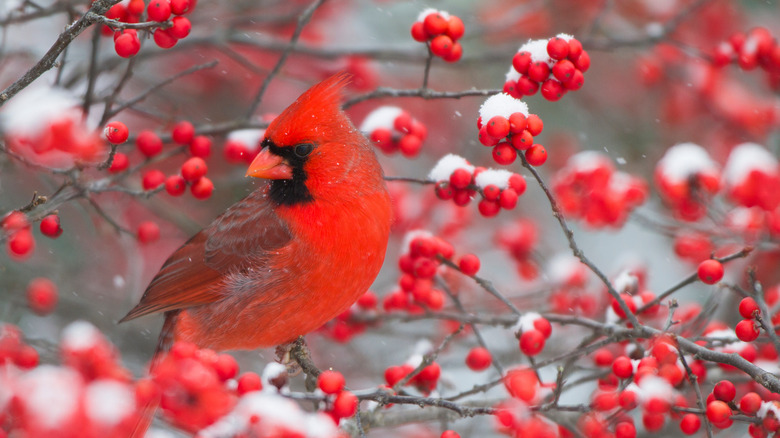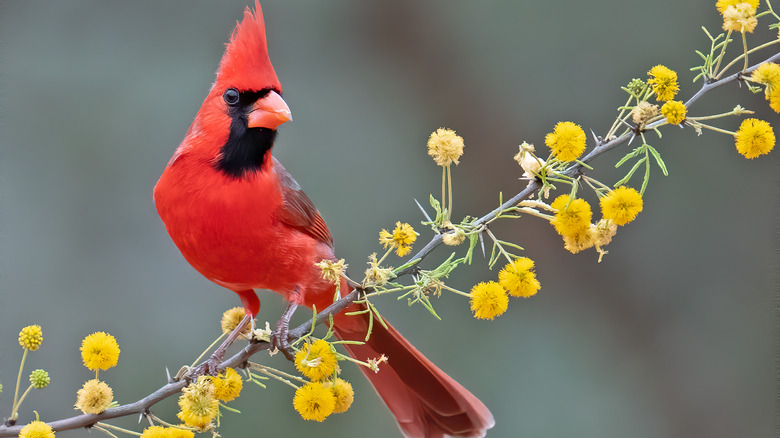Keep These Inviting Colors Around Your Garden If You Want To See More Cardinals
Though we can never really know for sure what colors cardinals and other birds prefer, observation of their behavior has yielded some insights. Flowers are sometimes named for their appeal to birds: like hummingbird mint, or cardinal flowers (red lobelia). According to some bird experts (like the folks at Bird Informer and Perky Pet), cardinals seem to be attracted to plants and other objects with red and pink colors, as well as yellow and blue, but overall prefer natural colors that help lend them camouflage.
From a marketing standpoint, bird feeders and birdhouses are sometimes designed with colors similar to the birds they're meant to attract (like blue for bluebirds, or yellow for goldfinches). Feeders designed for hummingbirds are often red, and it seems widely known that hummingbirds are attracted to red flowers. While we often associate bird decoys with hunting, many garden shops sell statues of various birds, from flamingoes to blue jays, with the idea that these may attract our favorite birds (provided they tend to live in the area; flamingoes will not visit your yard in Vermont, alas). Cardinals, being so popular and well-loved, are a popular motif for these pieces of garden art. But will these objects actually attract cardinals?
To draw more cardinals to your yard, you've probably already looked into what kind of foods they like, and what kinds of feeders they're more likely to visit. Considering what colors may attract them may also be a way to draw more cardinals.
Use natural colors to attract cardinals
Recent research drawing on the knowledge of birds' visual acuity and sensitivity to color found that colors with a "high energy wavelength," like green, purple, and blue (also colors widely found in nature), were more attractive to birds than colors with a "low energy wavelength" like yellow or red. The researchers theorized that yellow and red, being "warning" colors in nature, might be less attractive to birds. Yet some bird experts suggest cardinals are also attracted to red and yellow. Perhaps by experimenting with colors, you can find the ones that attract more cardinals.
Cardinals and other birds like to feel safe from predators while feeding, which is a vulnerable time. If you have a large yard with a lot of open space, consider a feeder in neutral, natural colors such as green or brown, and place it near where there is some natural protection such as next to a tree, large shrub, or vine-covered fence. Evergreens provide shelter all year round. This kind of arrangement, surrounded by green foliage, may help cardinals feel better protected when they feed.
Depending on where you put it, a brightly-colored feeder could be suitable for a spot where there is brightly colored fruit or foliage, such as in a grape arbor (cardinals love grapes!) or in a red-leafed Japanese maple tree. Try placing a bright red feeder in your Japanese maple tree, or a purple or blue one in the grape arbor.
Brightly colored berries attract cardinals
Many birds feed on berries and small fruits like crabapples. These brightly-colored fruits are a big part of the cardinal's diet, and their bright red coloring is in part due to a steady diet of berries! Planting trees and shrubs that provide shelter and produce tasty small fruits will definitely help attract cardinals to your yard. The combination of food and shelter is important: the bright red male cardinal is a target for predators, and cardinals' tendency to fly fairly low to the ground can make them easy prey. So providing plants that offer them some protection is important. Fortunately there are many trees and shrubs that provide both food and shelter.
Serviceberry, crabapple, mulberry, currant, blueberries, black or red raspberry, elderberry, viburnum, beautyberry, and hawthorn are but a few trees and shrubs that produce red, purple, and blue berries that are very attractive to songbirds, drawing them near and providing tasty snacks. Cardinals love shrubs with dense branching for protection which includes the berry bushes mentioned here.
Cardinals also tend to visit trees and shrubs that produce red berries in winter, such as American holly and winterberry. Ornamental crabapples often hold onto their tiny fruits past the first few frost dates, so they also provide good winter shelter and food for cardinals.
Cardinals love yellow
Cardinals (and other songbirds like warblers and goldfinches) are said to be attracted to the color yellow in the garden. The theory is that the color is bright and easy to see, and is visible even in darkness. Cardinals are more likely to feed at dawn and dusk, as they try and avoid predators, so yellow colors may attract them to your feeding areas at these darker times of day. There are plastic finch feeders available in bright yellow. You can also paint a wooden bird feeder yellow to attract more songbirds (but be aware cardinals do not like traditional birdhouses, which might make them feel vulnerable).
You may have noticed that when you have a pair of cardinals visiting your feeder, male and female, the male will show up first to make sure the "coast is clear" for his partner. Cardinals appreciate feeding stations where there is a bit of protection and shelter, so if you have a way to hang your feeder near shrubs or trees, cardinals may be more likely to visit. Densely-branched forsythia, with their bright yellow flowers in spring, are a good spot to hang a feeder.
You can also try planting yellow flowers near the birdfeeder area. Spring-blooming yellow flowers include daffodils, crocus, columbine, irises, and tulips. Summer yellows include yarrow, coreopsis, sunflowers, snapdragons (which bloom through autumn), and daylilies. Autumn yellows include mums, dahlias, rudbeckia, echinacea (which also come in pink and provide tasty seeds), goldenrod, and helianthus.
Colors to avoid when trying to attract cardinals
While there is a fair amount of conflicting information on how cardinals and other birds see and interpret color, it's interesting to look at which colors of plants or objects attract different kinds of birds. Some bird experts have noted that white flowers tend to not attract birds as readily as other colors. White is a color that birds associate with danger or warning, and birds with white tail or underwing feathers will sometimes flash them at other birds, it is believed, to communicate danger from predators. The question is: do cardinals avoid white flowers?
Cardinals, being very alert to predators due to their own bright feather coloring, are certainly aware of potential dangers. Yet cardinals are also often attracted to blossoming trees in spring, perhaps because they want to be near potential food sources when fruits and berries appear later. Trees with white blossoms often attract cardinals, such as elderberry, hawthorn, cherry, and crabapple.
While some brightly-colored objects in your yard might appeal to cardinals, there are some things to avoid that may be harmful. Cardinals can become confused around reflective surfaces such as mirrors and windows, which may cause them to attack their own reflections. This can cause stress and possibly lead to cardinals injuring their beaks. So when installing garden decor, avoid metallic or other shiny surfaces. Place bird decals on glass windows to prevent birds flying into them.




